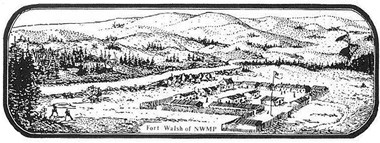The North West Mounted Police force had a varied and colourful story. Saskatchewan historian John H. Archer describes their march to the West as a “saga of endurance.” He says that they were largely amateurs in 1874, and one main mistake was to not hire the services of Métis scouts available at the Red River settlement when they passed through there, buying supplies for the rest of the march. The force later recognized the error and did hire scouts, one well known in the North West was Gerry Potts, who with his knowledge of the rugged country would have saved the men so much discomfort, misery, illnesses, and some desertions along the way, plus finding feed for their horses and oxen. Towards the end of their march west, they were lucky to be able to meet up with the International boundary survey crews at the Wood Mountain area, who were able to help with advice and supplies. The Mounted Police overcame their hardships to become professionals practically overnight. They imposed law with only minor disruptions, and soon built two forts — Fort Macleod in what is now Alberta and in 1875, Fort Walsh in the Cypress Hills in what is now Saskatchewan. One trip that some of the members of the force could look forward to was to go south 150 miles to Fort Benton, Montana. This fort situated on the upper Missouri River, dates back to 1846. It had stores, saloons, hotels, gambling parlours, etc. One interesting fact was that the Dominion Government made arrangements with Benton merchant, I.G. Baker to be the paymaster for the North West Mounted Police. For a few years, until there were banks in the North West Territories, members of the force took the trail to Fort Benton for their pay, for a variety of supplies and for entertainment. Fort Walsh was the forces’ most important fort and their most heavily armed headquarters until it was closed in 1882.
Contact Terri Lefebvre Prince,
Heritage Researcher,
City of Yorkton Archives,
Box 400, 37 Third Avenue North
Yorkton, Sask. S3N 2W3
306-786-1722
[email protected]

.png;w=120;h=80;mode=crop)


